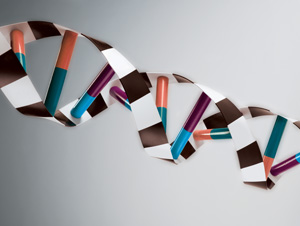Genomics 101
Genomics, the study of DNA sequences, has received a lot of interest and research investment in the beef and cattle industry. Genomics is important to the industry, especially the seedstock sector, because it has the potential to substantially reduce production costs and improve the value of beef and cattle. For example, if DNA tests could accurately predict the genetic merit of a potential breeding animal (for mature cow size, feed efficiency or tenderness, for example), culling decisions could be made at birth and save the breeder a lot of time, effort and expense.
All living animals have a genetic blueprint, which is recorded in deoxyribonucleic acid (DNA). Based on the DNA blueprint’s instructions, protein from the diet is digested into approximately 20 different amino acids. The amino acids are absorbed into the bloodstream, travel to various locations in the body, and then assemble into new proteins. Proteins make up several important parts of cattle, including enzymes, hormones, hooves, hair, horns, skin, muscles, ligaments, tendons, internal organs, cartilage, and even parts of the skeleton.

DNA is located in chromosomes. Beef cattle have 30 pairs of chromosomes, which are found in almost all of the cells of the body. The chromosomes, twisted and coiled tightly, are too small to see with the naked eye but would be approximately 10 feet long if they were stretched out.
The DNA resembles a long chain. Each link in the chain is one of four small molecules abbreviated by the letters A, T, G and C. The animal’s cellular machinery reads the genetic blueprint three letters at a time, such as ‘ATC’, ‘GTA’, ‘CAT’, ‘TAG’, etc.
Some of the three-letter codes instruct the cellular machinery to “start reading the DNA here”. Other codes correspond to specific amino acids, so the order of the three-letter codes in the DNA blueprint corresponds to the order of the amino acids in the protein that will be manufactured. Finally, some codes tell the cellular machinery to “stop reading here”. The DNA sequence from the “start reading” code to the “stop reading” code is called a gene. Some genes correspond to structural proteins (e.g. muscle), some code for hormones (e.g. testosterone), and some code for enzymes (e.g. amylase, which digests starch).
A change in the DNA sequence is called a mutation. Some mutations have no impact on the animal. Because there are 64 three-letter codes and only 20 amino acids, each amino acid has more than one code. It is possible for one letter in the code to change yet it will still call for the same amino acid – a ‘silent mutation’.
Other mutations, or changes in the code, have more profound effects. For example, myostatin is a hormone that tells muscle to stop growing (“myo” means muscle, and “statin” means stop). The myostatin gene is located on chromosome 2. Researchers have found at least three different mutations that all result in a non-functional myostatin hormone. One mutation simply exchanged a “G” for an “A” and changed the amino acid sequence in the hormone. Another mutation occurred when 11 letters in a row were lost. This resulted in the loss of some amino acids, and changed the order of other amino acids. A third mutation created a “stop reading” code halfway through the gene, so the hormone was too short. In all three of these cases, the myostatin hormone didn’t work properly, so the signal that normally slows muscle growth was missing. These three different mutations result in the “double-muscled” appearance of the Piedmontese, Belgian Blue and Marchigiana breeds.
Another example of a mutation that causes significant changes in the animal is with the leptin gene, which is located on chromosome 4 and codes for a hormone that regulates appetite and fat deposition. Researchers at the Universities of Saskatchewan and Alberta have found a number of mutations in the leptin gene that result in measurable differences in backfat depth, lean yield and days to market. The impact of these mutations on marbling is less clear, which suggests that it is possible to select for leaner carcasses without always reducing marbling score.
Many animal traits are influenced by more than one gene. For example, the calpain gene (chromosome 29) codes for an enzyme that is involved in muscle protein breakdown during post-mortem aging. The calpastatin gene on chromosome 7 codes for an enzyme that regulates calpain, so mutations in either of these genes can affect tenderness.
The study of genomics is complex, but understanding of DNA in cattle has progressed, and some reliable DNA tests have been developed. With more time and investment in the study of genomics, the beef industry can begin to realize the great potential of genomic technology.
Click here to subscribe to the BCRC Blog and receive email notifications when new content is posted.
The sharing or reprinting of this BCRC Blog article is welcome and encouraged. Please provide acknowledgement to the Beef Cattle Research Council, list the website address, www.BeefResearch.ca, and let us know you chose to share the article by emailing us at [email protected].
We welcome your questions, comments and suggestions. Contact us directly or generate public discussion by posting your thoughts below.